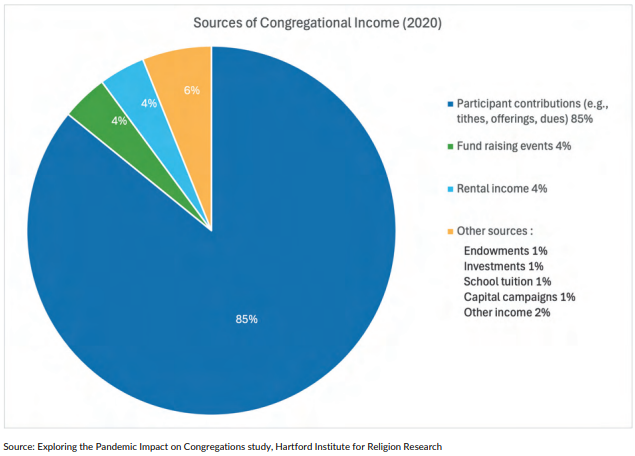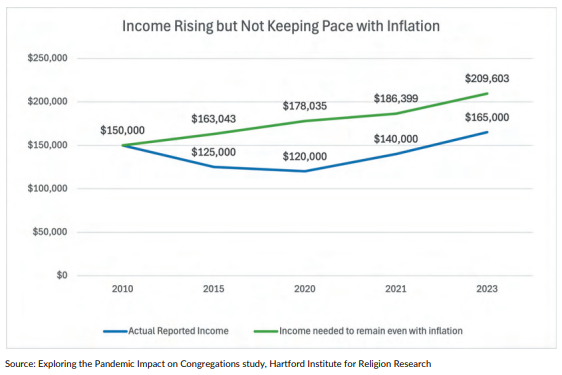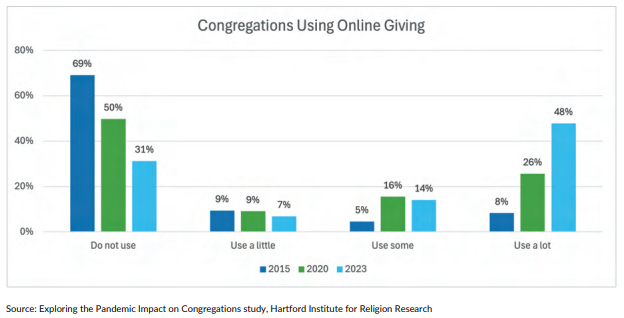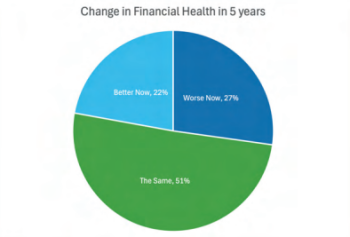
Inflation has everyone thinking twice about their finances, even those who stay connected with their faith.
CNBC shared recently that the consumer price index — which measures how fast prices are changing across the U.S. economy — rose 2.5% in August from a year ago. (Credit: U.S. Department of Labor reported). Whether we stay inside the church or begin frantically shopping outside of it, the sense of desperation attacks us all.
In a world of faith and trust in the Spirit of God, the Church–along with a notable nationwide study–is given on salient response: give more to make up for those who give less.
But is this a sustainable model for the future? It may have to be depending on what we glean from statistics and research.
Economic Woes Continue to Plague the Church

A majority of churches struggled since the pandemic to provide for their communities and support their people. Today, 16% of U.S. adults still attend church remotely by streaming it online. Whether that’s because of inflation and the job market, or still struggling because of gas prices, fewer people are in the seats. Does that mean there fewer donations in collections?
Churches are like any business; they require money to stay open.
Bring the full tithe into the storehouse, so that there may be food in my house, and thus put me to the test, says the Lord of hosts; see if I will not open the windows of heaven for you and pour down for you an overflowing blessing.
The storehouse has the same utilities, overhead, and payments as most homes and businesses do. Only, most of those churches do not have the same revenue-generating sources, so they have to make do with other ideas:

According to a recent study, it has been the work of the few to help keep the storehouse open amid America’s inflation. Faith Communities Today published “Finances and Faith: A Look at Financial Health Among Congregations in the Post-Pandemic Reality.” The research covered thousands of denominations and U.S. congregations.
Among the key findings is a startling statistic: Fewer than 50% of Americans currently hold formal memberships in churches, and more Protestant churches are closing than opening nationwide.
Since utilities, actualities, and ministries aren’t going anywhere during the average Sunday service, the bills will show up as scheduled every month.
In 2023, the typical congregation had a median of 60 in-person weekly worship attendees. In this average-sized faith community, the median income was $165,000 and the median amount spent in the most recent fiscal year was $160,000,” researchers wrote.
“These figures represent increases compared to the amounts reported in 2020 ($120,000 income, $108,000 expenses) and is the highest income reported in nearly 15 years, even though 2023 saw the lowest average worship attendance since the survey began in 2000.
Despite a less active and fruitful congregation, inflation affects us all. According to the study, those who make up the average congregation of only 60 in-person weekly worship congregants must pick up the slack for those who aren’t attending or donating.

Inflation Prolongs the Plight of the Pandemic

Technology creates consistency and equalization among all churches because it provides parishioners, congregants, and members of smaller houses of worship the same capabilities as those in larger ones. The only problem is that it can enable the same behaviors.
The national study showed when online giving hit its peak interest, 69% of congregations used it. The giving was easy. It was encrypted. And it prevented the “passing the plate” discomfort of those who may not have their tithe or a donation. Today, that number is down to 48%.

The missing link may be found in another national study that says “37% of regular church attendees don’t give money to church.” Without the regular influx of donations to churches or the considered regular attendees in churches, how will the nearly 350,000 churches in America continue to fight inflation or the post-pandemic decline of business?

One statistic is clear–the rebound won’t be because church attendees are making more.
The large proportion of congregations that reported being in better or equal fiscal health in 2023 compared to 2018 is interesting considering the findings discussed previously about inflation and the difference in purchasing power in the 2010s and 2023. These congregations could have attendees who have increased their giving. Additionally, government loans may have helped weather the past few years.
Likewise, certain congregations may have reduced overall expenses by offering fewer programs, cutting staff, or finding alternative revenue sources to compensate and bolster their financial situation. Either way, this pattern could signal an ongoing effort of the congregation to assess their
situation and adapt accordingly.
Statistics open the conversation to a deductive reason that shows people not attending physically could provide an excuse to not give personally. That is creating a problem that affects all churches financially. And, if so, where does that leave this nation spiritually?


